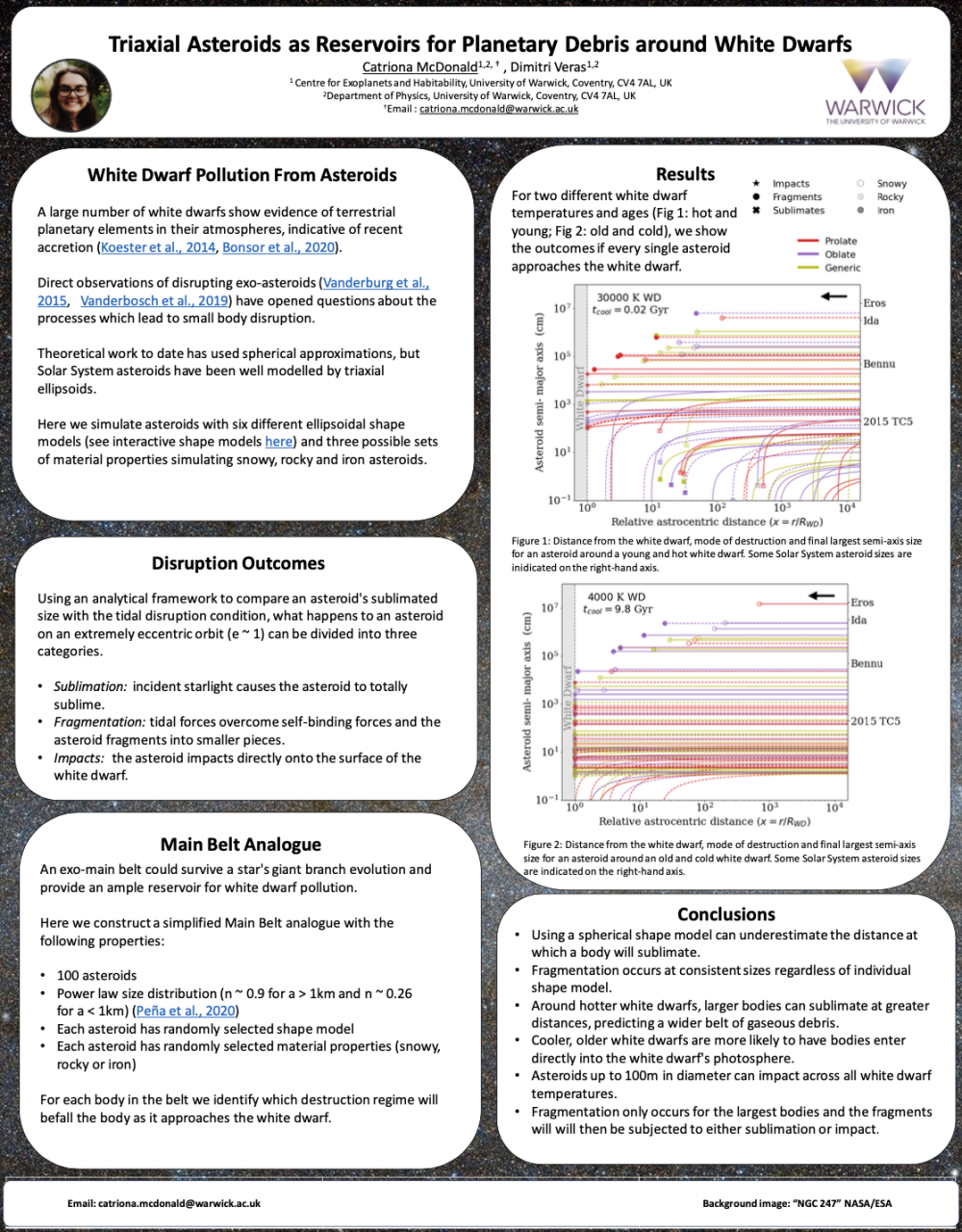Research News & Highlights
UKI Discs Meeting 2024 to be hosted at the University of Warwick
Our discs group recently started the UK & Ireland (UKI) Discs community, where we aim to bring together the disc communities across the UK & Ireland for those working on astrophysical discs on various scales, from circumplanetary to galactic discs. We are excited to announce the first UKI Discs Meeting will be hosted at the University of Warwick from the 9th - 11th of September 2024 and will focus on protoplanetary discs and debris discs (including white dwarf discs). To register and find out more, follow the link hereLink opens in a new window.
The abstract submission deadline for talks/posters is the 12th of May 2024.

Continuing to hide signatures of gravitational instability in protoplanetary discs with planets
Sahl Rowther, Rebecca Nealon, Farzana Meru
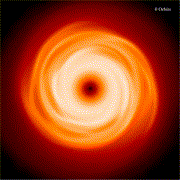
We conduct gas and dust hydrodynamical simulations of protoplanetary discs with one and two embedded planets to determine the impact that a second planet located further out in the disc has on the potential for subsequent planet formation in the region locally exterior to the inner planet. We show how the presence of a second planet has a strong influence on the collection of solid material near the inner planet, particularly when the outer planet is massive enough to generate a maximum in the disc’s pressure profile. This effect in general acts to reduce the amount of material that can collect in a pressure bump generated by the inner planet. When viewing the inner pressure bump as a location for potential subsequent planet formation of a third planet, we therefore expect that the mass of such a planet will be smaller than it would be in the case without the outer planet, resulting in a small planet being sandwiched between its neighbours – this is in contrast to the expected trend of increasing planet mass with radial distance from the host star. We show that several planetary systems have been observed that do not show this trend but instead have a smaller planet sandwiched in between two more massive planets. We present the idea that such an architecture could be the result of the subsequent formation of a middle planet after its two neighbours formed at some earlier stage.
"Sandwiched" Planet Formation
Matthew Pritchard, Farzana Meru
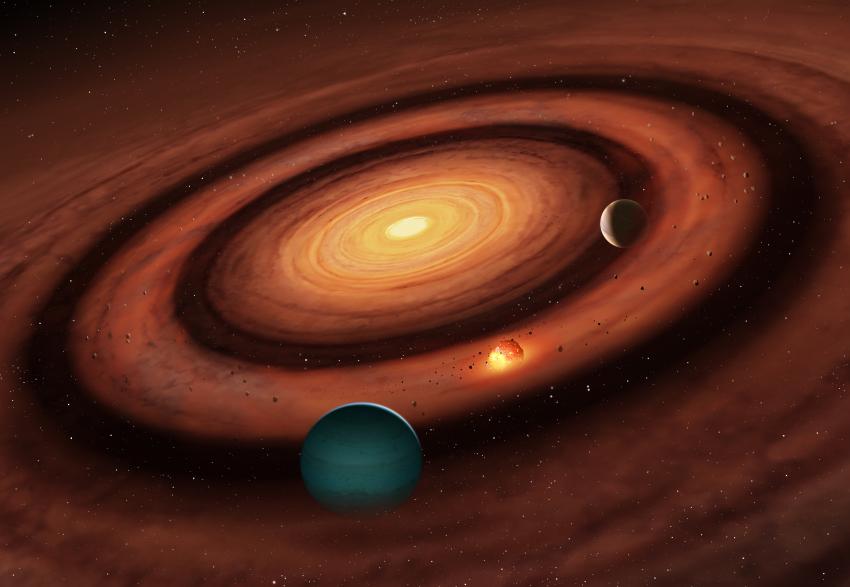
We conduct gas and dust hydrodynamical simulations of protoplanetary discs with one and two embedded planets to determine the impact that a second planet located further out in the disc has on the potential for subsequent planet formation in the region locally exterior to the inner planet. We show how the presence of a second planet has a strong influence on the collection of solid material near the inner planet, particularly when the outer planet is massive enough to generate a maximum in the disc’s pressure profile. This effect in general acts to reduce the amount of material that can collect in a pressure bump generated by the inner planet. When viewing the inner pressure bump as a location for potential subsequent planet formation of a third planet, we therefore expect that the mass of such a planet will be smaller than it would be in the case without the outer planet, resulting in a small planet being sandwiched between its neighbours – this is in contrast to the expected trend of increasing planet mass with radial distance from the host star. We show that several planetary systems have been observed that do not show this trend but instead have a smaller planet sandwiched in between two more massive planets. We present the idea that such an architecture could be the result of the subsequent formation of a middle planet after its two neighbours formed at some earlier stage.
RAS Specialist Meeting - Formation, Evolution and Dispersal of Protoplanetary Discs
Amena Faruqi -- Simulating the Transit of a Binary System by a Circumbinary Disc in the HD98800 System
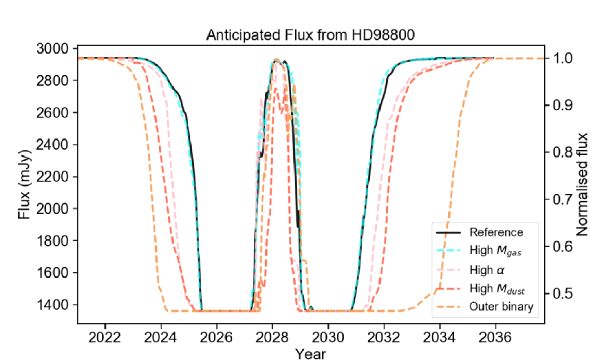
The properties of circumbinary discs play a significant role in star-disc interactions in binary systems. However, there are gaps in our current understanding of how various disc properties, such as the disc mass, viscosity, and dust-to-gas ratio, can affect the dynamics and evolution of such a system. In order to better understand the influence of these properties, it would be ideal to study a system where the stellar parameters are well-constrained, and the disc can be imaged. One such system is the HD98800 system, a quadruple star system consisting of two binaries, AaAb and BaBb, one of which (BaBb) has been observed to have a circumbinary protoplanetary disc encircling it. In 2026, it has been predicted that the circumbinary disc of BaBb will pass in front of AaAb. This provides a rare opportunity – analysing the light curve of the system during this transit could allow us to constrain certain properties of the disc. The goal of this research is to inform future observations and subsequent study of the system and transit, as well as providing some insight into the properties of circumbinary protoplanetary discs.
In this presentation, I will discuss my research using hydrodynamical simulations and radiative transfer modelling to create synthetic observations of the HD98800 system and anticipated transit. To consider how observations differ as a result of variations in disc properties, a grid of models defined by a parameter space was created. I will discuss how this set of results can be compared to identify features in the synthetic light curves that can be used to make inferences about disc properties. I will also consider how my synthetic observations compare to past observations of the system and more broadly, how certain disc properties can be constrained using simulation data.
Rocking shadows in protoplanetary discs
Rebecca Nealon, Daniel Price and Christophe Pinte
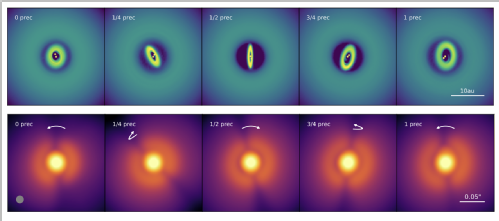
Astronomers from the University of Warwick reveal a new phenomenon dubbed the “rocking shadow” effect that describes how discs in forming planetary systems are oriented, and how they move around their host star. The effect also gives clues as to how they might evolve with time. Dr Rebecca Nealon presented the new work this week at the 2022 National Astronomy Meeting at the University of Warwick.
Warping Away Gravitational Instabilities in Protoplanetary Discs
Sahl Rowther, Rebecca Nealon, Farzana Meru
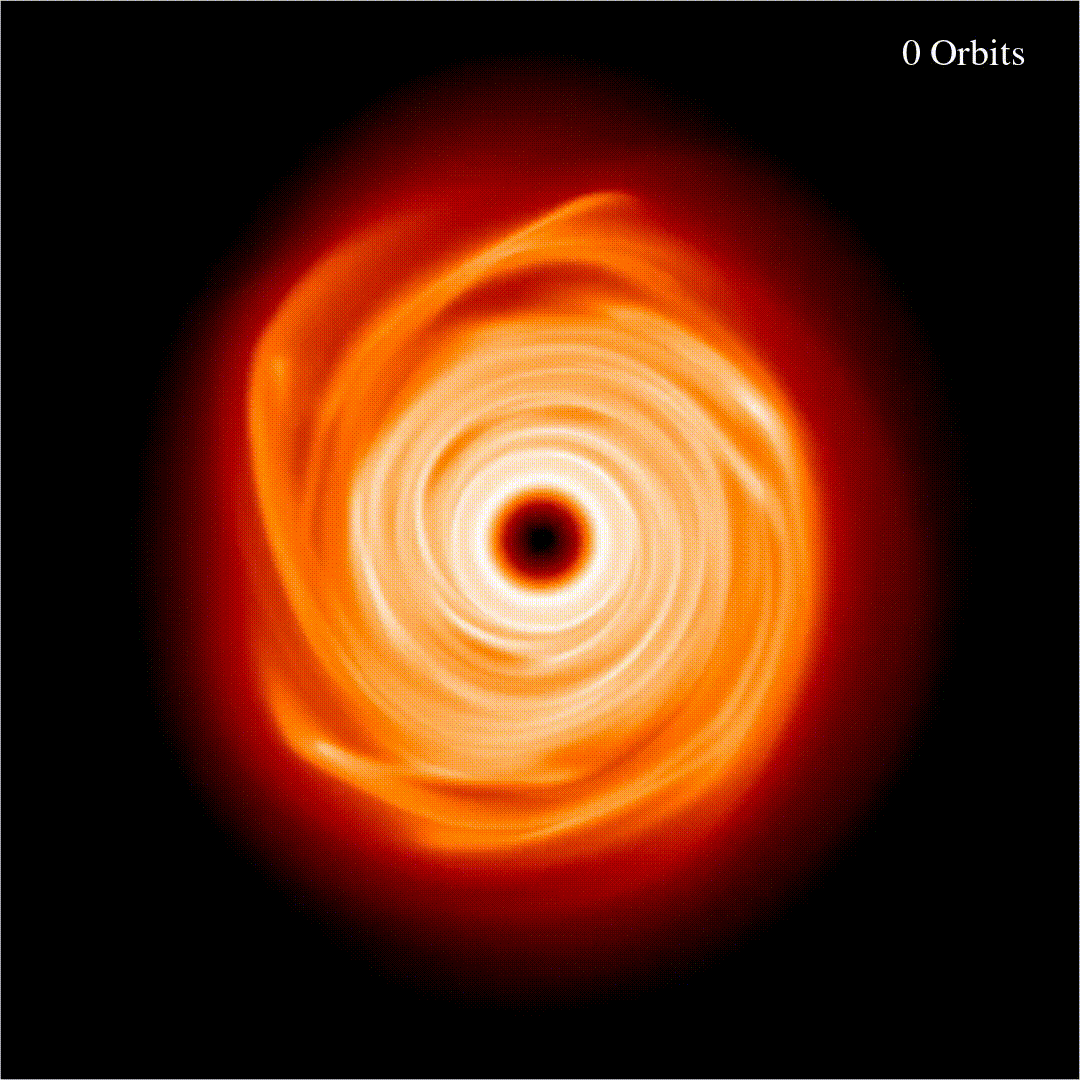
We perform 3D SPH simulations of warped, non-coplanar gravitationally unstable discs to show that as the warp propagates through the self-gravitating disc, it heats up the disc rendering it gravitationally stable. Thus losing their spiral structure and appearing completely axisymmetric. In their youth, protoplanetary discs are expected to be massive and self-gravitating, which results in non-axisymmetric spiral structures. However recent observations of young protoplanetary discs with ALMA have revealed that discs with large-scale spiral structure are rarely observed in the midplane. Instead, axisymmetric discs with some also having ring & gap structures are more commonly observed. Our work involving warps, non-coplanar disc structures that are expected to commonly occur in young discs, potentially resolves this discrepancy between observations and theoretical predictions. We demonstrate that they are able to suppress the large-scale spiral structure of self-gravitating protoplanetary discs.
UKEXOM 2021
Sahl Rowther -- Giant Planets Can Suppress Gravitational Instabilities In Protoplanetary Discs
The work covered in this talk is described in Rowther et al. 2020.
Five Years After HL Tau
Sahl Rowther -- Are Gravitationally Unstable Protoplanetary Discs Rare?
The work covered in this talk is described in Rowther et al. 2020.
Rebecca Nealon -- Spirals, Shadows and Precession in HD 100453 Part 2
Part 1 can be viewed here.
Dimitri Veras - Constraining Planet Formation Around 6-8 Solar Mass Stars
The work covered in this talk is described in Veras et al. 2020.
Hiding Signatures of Gravitational Instability in Protoplanetary Discs with Planets
Sahl Rowther, Farzana Meru, Grant M. Kennedy, Rebecca Nealon, Christophe Pinte

We carry out three-dimensional smoothed particle hydrodynamics simulations to show that a migrating giant planet strongly suppresses the spiral structure in self-gravitating disks. We present mock Atacama Large Millimeter/submillimeter Array (ALMA) continuum observations that show that in the absence of a planet, spiral arms due to gravitational instability are easily observed. Whereas in the presence of a giant planet, the spiral structures are suppressed by the migrating planet resulting in a largely axisymmetric disk with a ring and gap structure. Our modeling of the gas kinematics shows that the planet's presence could be inferred, for example, using optically thin 13C16O. Our results show that it is not necessary to limit the gas mass of disks by assuming high dust-to-gas mass ratios in order to explain a lack of spiral features that would otherwise be expected in high-mass disks.
Exoplanet Demographics
Christopher Manser -- Doppler Imaging of a Second Planetary Debris Disc Around a White Dwarf
Talk begins at 4:16:02.
Dimitri Veras -- Full-lifetime Simulations of Planetary Systems
Talk begins at 2:00:00.
Catriona McDonald -- Triaxial Asteroids as Reservoirs for Planetary Debris around White Dwarfs
Here, we present an analytical framework incorporating tidal, self-gravitational and internal strength forces to triaxial ellipsoids approaching a white dwarf on extremely eccentric (e ~ 1) orbits. Such extreme orbits could be produced by dynamic interactions with planets in the white dwarf system. The subsequent disruption of the asteroids is split into three distinct regimes: tidal fragmentation, sublimation, and direct impact. This framework is extended to cover a simplified Main Belt analogue of 100 planetesimals with an observational size distribution and randomly chosen shape model and material, for a range of white dwarf temperatures. We find that using a spherical shape model consistently underestimates where sublimation occurs and overestimates fragmentation distance. The small spatial scales of white dwarf planetary systems can cause these discrepancies to have a large effect on predicted debris distributions. Our results allow us to place constraints on the expected planetary debris from asteroids at different white dwarf cooling ages and motivates future studies to include more accurate shape models

